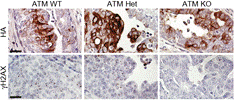Veterinary and Biomedical Sciences, Department of
Document Type
Article
Date of this Version
2006
Citation
Journal of Neuroscience Research (2006) 83: 415-431. DOI: 10.1002/jnr.20748.
Abstract
Myelin proteolipid protein (PLP), the major protein of mammalian CNS myelin, is a member of the proteolipid gene family (pgf). It is an evolutionarily conserved polytopic integral membrane protein and a potential autoantigen in multiple sclerosis (MS). To analyze antibody recognition of PLP epitopes in situ, monoclonal antibodies (mAbs) specific for different regions of human PLP (50–69, 100–123, 139–151, 178–191, 200–219, 264–276) were generated and used to immunostain CNS tissues of representative vertebrates. mAbs to each region recognized whole human PLP on Western blots; the anti-100–123 mAb did not recognize DM-20, the PLP isoform that lacks residues 116–150. All of the mAbs stained fixed, permeabilized oligodendrocytes and mammalian and avian CNS tissue myelin. Most of the mAbs also stained amphibian, teleost, and elasmobranch CNS myelin despite greater diversity of their pgf myelin protein sequences. Myelin staining was observed when there was at least 40% identity of the mAb epitope and known pgf myelin proteins of the same or related species. The pgf myelin proteins of teleosts and elasmobranchs lack 116–150; the anti-100–123 mAb did not stain their myelin. In addition to myelin, the anti-178– 191 mAb stained many neurons in all species; other mAbs stained distinct neuron subpopulations in different species. Neuronal staining was observed when there was at least approximately 30% identity of the PLP mAb epitope and known pgf neuronal proteins of the same or related species. Thus, anti-human PLP epitope mAbs simultaneously recognize CNS myelin and neurons even without extensive sequence identity. Widespread anti-PLP mAb recognition of neurons suggests a novel potential pathophysiologic mechanism in MS patients, i.e., that anti-PLP antibodies associated with demyelination might simultaneously recognize pgf epitopes in neurons, thereby affecting their functions.
Correlation of Staining with Per Cent Identities of pgf Proteins and PLP 50-69 and 100-123
Reddy 2006 JNR Monoclonal Antibodies to Distinct Regions of Human Myelin Proteolipid Protein GOV AUTH suppB.pdf (28 kB)
Correlation of Staining with Per Cent Identities of pgf Proteins and PLP 139-51 and 178-191
Reddy 2006 JNR Monoclonal Antibodies to Distinct Regions of Human Myelin Proteolipid Protein GOV AUTH suppC.pdf (106 kB)
Correlation of Staining with Per Cent Identities of pgf Proteins and PLP 200-219 and 264-276
Included in
Medical Immunology Commons, Medical Microbiology Commons, Medical Molecular Biology Commons



Comments
Published by Wiley-Liss. US government work.